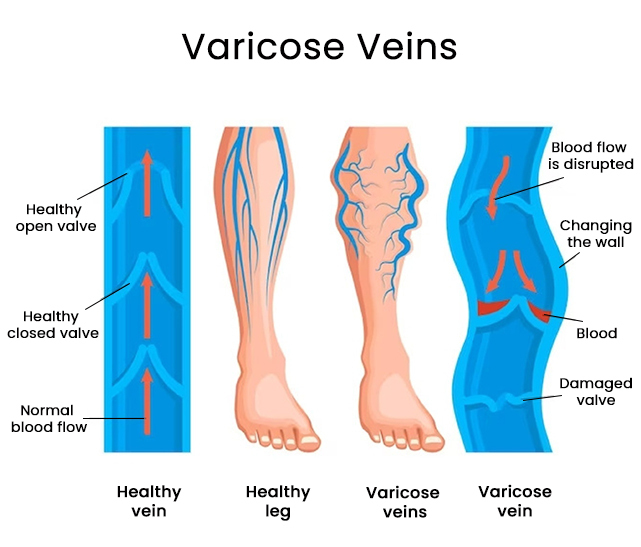Varicose veins are the twisted and enlarged veins in your legs. While these veins aren’t usually life-threatening, many patients are left feeling conscious about their appearance. But varicose veins might cause dangerous reactions if left unchecked or untreated, as they might be signs of an underlying medical condition. When hit or cut, varicose veins might bleed, causing a medical emergency.
So what should you do when you’re bleeding from varicose veins? Your priority should be to stop the bleeding when your varicose veins suddenly get hit or cut. Elevate your legs and apply pressure to the bleeding site for 15 minutes. If the bleeding from your varicose vein hasn’t stopped yet, go for another 15 minutes and repeat this 3 times. Seek medical attention if the bleeding seems too much.
What to Do with Varicose Veins that Bleed
Since varicose veins are veins enlarged with blood due to poor blood flow, it no longer comes as a surprise that it will bleed once you hit or cut it. Many patients run into this accident when shaving their legs and doing their daily activities. Bleeding is one of the serious reactions of varicose veins, aside from leg ulcers and blood clots.
Bleeding varicose veins can be a serious medical emergency, especially if you’ve already lost a large amount of blood or you’re experiencing internal bleeding. If your varicose veins happen to bleed, the first thing you might want to do is to stop it. You may elevate your legs, apply pressure, and call an emergency.
1) Elevate Your Legs
You may elevate your legs above the heart level. This allows your legs to go against gravity and reduce the blood gushing in the vein, reducing the bleeding. You may want to remain in this position while the bleeding hasn’t stopped yet.
2) Apply Pressure to Stop the Bleeding
To stop the bleeding, you can apply pressure on the ruptured vein firmly using a clean bandage. Do this for 15 minutes, and be sure not to release sooner, only to check if the bleeding has already stopped. If the bleeding hasn’t subsided yet, go for another 15 minutes — repeat this step 3 times, giving you a full 45 minutes.
3) Call Emergency
Prepare to call for an emergency for the patient to seek immediate medical attention if the bleeding hasn’t stopped yet. Or even if it’s already stopped, you might want to go to a vein specialist to assess and resolve the affected vein properly.

Why Do Varicose Veins Bleed?
Patients who’ve nicked their varicose veins may find that the bleeding is more intense than expected, given the size of the cut. Aside from it being a blood vessel, varicose veins that have ruptured contain more blood than usual.
Varicose veins are caused by blood collected in the vein due to poor blood flow. Veins contain valves that prevent blood from flowing back as it circulates to the heart. But with a weakened vein or vein valve, the blood returns and collects in the veins. This makes the veins stretch, twist, and become enlarged, making them more vulnerable to internal and external rupture.
Varicose veins may be prone to rupture due to external trauma because of their bulging appearance and the weakened skin protecting them. Some instances might cause varicose veins to bleed, like:
- Scratching a vein accidentally
- Bumping your leg against a hard surface
- Objects or furniture falling on your leg accidentally
- Your pet accidentally scratching it
- Injuries from falling or tripping
- Shaving your legs
While the chances are slim, blood loss from ruptured varicose veins is possible. Patients may also experience a fatal hemorrhage, but this also happens rarely. Consult a vein specialist to learn more about the risks of your varicose veins.
The Best Treatment for Ruptured Varicose Veins at Downtown Vein & Vascular Center
Resolve your varicose veins completely to significantly prevent bleeding. You may rely on the interventional solutions we offer at Downtown Vein & Vascular Center under the care of the best vein specialists with the most sophisticated tools and techniques.
| Varicose Vein Treatment | Description |
| Sclerotherapy | Closes the affected vein upon receiving injections of the sclerosant |
| Micro-Phlebectomy | Removes the damaged vein under the skin after creating small incisions |
| Endovenous Laser Treatment | Closes the damaged vein with heat from the ELAS device, as it targets the vein wall lining via an inserted fiber. |
Read more: Should I Be Concerned About Dark Veins?
Quality Treatments and Preventive Procedures for Varicose Vein Rupture at Downtown Vein & Vascular Center
Varicose veins may also bleed due to the enlarged vein filled with blood and the weakened skin that makes it susceptible to rupture. If your varicose veins suddenly bleed, the first thing to do is to stop the bleeding. Elevate the legs, apply pressure, and call a medical emergency. You might want to manage your varicose veins better to avoid this situation or consider long-term relief from interventional solutions.
Downtown Vein & Vascular Center is one of the most reputable vascular clinics for providing the best solutions for removing varicose veins. With our top-rated vein specialists, patients can expect world-class services and customized vein treatment plans. Our state-of-the-art equipment also ensures smooth and convenient treatments. Schedule a consultation with us today.


